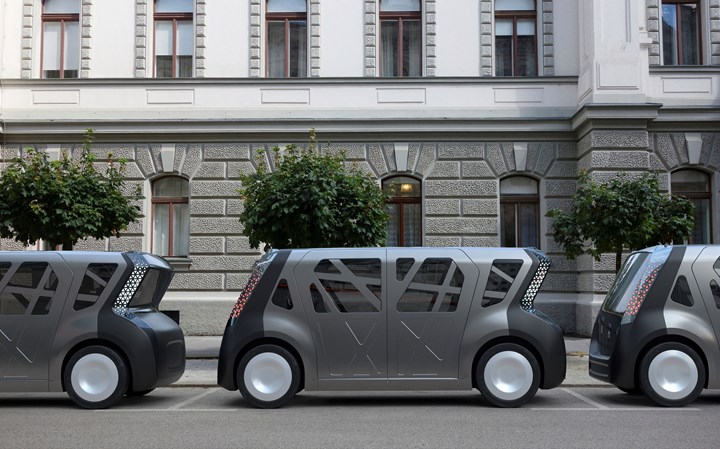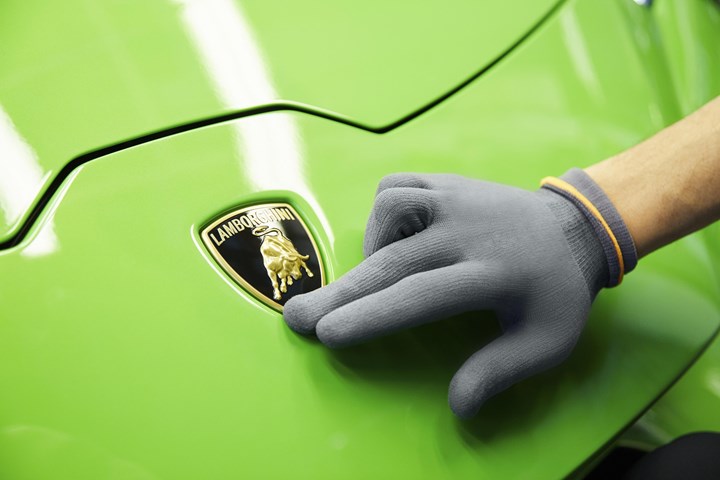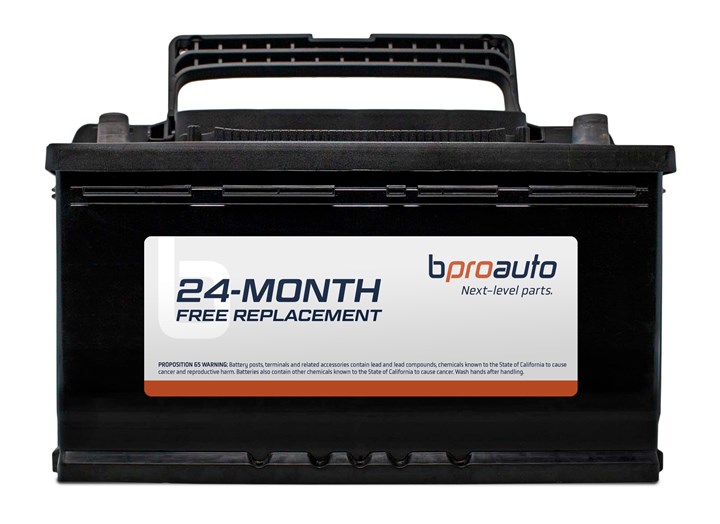on steel, Lambos, EVs in Europe, & spare parts
On a steel concept for autonomous mobility. . .Lambo’s big—and small—numbers. . .EVs in Europe. . .IONIQ 6. . .Stellantis parts play. . .still plenty of rapid prototyping. . .
Steel Drives Forward

Serious exercise in steel: although this autonomous, electric people mover is a concept. For now. (Image: WorldAutoSteel)
First, a quick history lesson.
In September 1993 a program sponsored by the federal government along with Ford, General Motors and the then-Chrysler, the Partnership for a New Generation of Vehicles (PNGV) was launched.
According to the U.S. General Accounting Office (all in, from FY 1995 to FY 1999, the government support was some $1.25-billion, so the GAO had an obvious interest):
“The goals of the partnership were to (1) significantly improve U.S. competitiveness in manufacturing, (2) implement commercially viable innovations from ongoing research in conventional vehicles, and (3) develop vehicles that can achieve up to three times the fuel efficiency of comparable 1994 family sedans, or approximately 80 miles per gallon, by 2004.”
Certainly #3 didn’t happen.
But in a letter to Congress in 2000 the GAO wrote:
“The partnership has made progress in implementing this goal [#2], with the manufacturers incorporating PNGV-related technologies into their conventional vehicles. Specifically, DaimlerChrysler reported the increased use of aluminum, magnesium, and composites to reduce weight. Ford reported that it has increased the use of aluminum and other lightweight components in its Lincoln LS luxury car, used advanced examination techniques to improve the manufacturing and durability of brake rotors, and reduced the emission of pollutants. General Motors reported progress toward the second goal, including the increased use of aluminum and other lightweight materials in engines and structural components. . . and the introduction of a composite truck bed on its 2001 Silverado pickup.”
What’s missing from the description of the #2 goal?
Steel.
Aluminum, magnesium, composites, and titanium were all part of the program.
But steel was pretty much left out.
So since then the steel industry—and not just in the U.S.—has been aggressively doing research to emphasize its relevance to meeting advanced demands in the auto industry.
And Now. . .
Like “Steel E-Motive,” a research program that WorldAutoSteel has been working on, along with engineering services firm Ricardo, for three years.
It resulted in steel-intensive structural concept designs for two electric, autonomous (Level 5), circa 2030 to 2035 vehicles:
- SEM1: a four-passenger urban transport
- SEM2: a six-passenger ex-urban commuter
Why transporters rather than passenger vehicles? we wondered.
George Coates, Technical Director, WorldAutoSteel , answers the organization has been looking into “emerging transportation disruptors.” Consequently: “Our research identified fully autonomous Mobility as a Service vehicles as a new vehicle class that OEMs and investors see as a sustainable transportation option, addressing many of these disrupters.”
And showing off what steel can do, Coates says:
- An ~86% total lifecycle emissions reduction for the SEM1 “assuming all contributing factors are applied—such as green steel, battery decarbonization, grid supply, autonomous vehicle factors, extended life and higher occupancy—when compared to a 2021 battery electric taxi operating in Europe with a lower vehicle occupancy and lifetime.”
- A 282-kg body structure, 25% lower than a reference vehicle
Then there’s affordability of the SEMI.
Neil McGregor, Chief Engineer, Vehicle Systems Integration, Ricardo Automotive and Industrial Division, EMEA, says the body-in-white has a cost of $1,203 and the total vehicle an MSRP of $40,406 “excluding autonomous systems and possible fleet purchase considerations.”
McGregor explains, “A chief cost savings was in the first-of-its-kind battery carrier frame. At a cost per vehicle of U.S. $154, it saves 37% mass, while reducing cost by 27% over benchmarked battery packaging.”
Other Factors
- Gage optimization. Material is thick where it needs to be.
- Elimination of the body-side outer through the use of scissor doors that cover the exposed portion of the cantrail and rocker
- Elimination of the conventional B-pillar with integrated hydroformed tubes
- The ability to use existing automotive stamping and assembly plants to produce the vehicle. (They figured the annual production rate would be 250,000 units.)
Steel(s)
Although it might be thought that there are just a few steel variants out there, know that for the development of the Steel E-Motive project they use:
- Mild (conventional) steels
- Interstitial-free steels
- Bake hardenable steels
- High-strength, low-alloy steels
- Dual phase steels
- Transformation-induced plasticity steels
- Ferritic-bainitic steels
- Complex phase steels
- Martensitic steel
- Twinning-induced plasticity steel
- Press-hardened (hot formed) steel
Odds are if the PGNV program was to be run today, steel would certainly play a big role among the materials selected.
///Small Numbers Can Result in Big Numbers (Not a Math Paradox)

When you make vehicles at Lamborghini volumes and sell them for Lambo prices, the personal touch is more than reasonable. (Image: Lamborghini)
One of the things that companies have had a tendency to do is expand their offerings with the hope expectation that more choices will lead to more sales.
An example—certainly a rarified example, but one nonetheless—that runs counter to this is Lamborghini.
When it announced its 2023 first half results a couple weeks ago it reported:
- €1,421 million in revenues, up 6.7% compared to the same period in 2022
- €456 million in operating income, a 7.2% increase
- A 32.1% return on sales
Here’s the notable part:
- Urus SUV
- Huracán sports car
That’s all Lambo has on the market right now.*
Two vehicles.
Sure, there are variants within the families.
But two vehicles, not a comprehensive suite.
Equally impressive: they obtained those results with deliveries of just 5,341 vehicles in the first half.
Understatement Alert
“The positive trend reinforces our expectation that we will close the year with further record results in all the key financial metrics, with profitability that confirms Lamborghini’s place among the leading brands in the luxury segment.”-- Paolo Poma, Managing Director and CFO of Automobili Lamborghini,
Of course, when you are building cars that cost north of $200,000 and can do so at some volume, results like Lamborghini’s, obviously, are attainable.
But it means having vehicles that are sufficiently desirable.
One More Thing
The single biggest market in H1 2023 for Lambo?
No, not China.
The U.S. Where 1,625 were delivered.
The Chinese mainland, Hong Kong and Macau combined took 450 vehicles.
*Lamborghini introduced the Revuelto, a high-performance hybrid sports car, in March. Its order book for the car is full for the next two years.
///
What Do EV Owners Think?

In addition to liquid fuels, Shell sells electrons, too. (Image: Kent Smith for Shell)
“From a global perspective, these are--alongside China--the most advanced EV markets across the world,” Florian Glattes, vice president, Shell eMobility Solutions, writes in his introduction to “EV Drive Survey Report 2023.”
The markets he is referencing are Belgium, France, Germany, the Netherlands, the UK, and Italy.
Maybe because the survey was conducted in Europe the U.S. was left off the list.
Maybe.
Glattes also writes: “I believe we are at an exciting tipping point and are well on our way to EV mass adoption.”
Well, if you’re in the business of providing charging services, it is better to be positive rather than otherwise.
(The other parts of Shell are probably keenly interested on the continuation of the purchase of liquid fuels so would be just as glad were the tipping point sometime in the future.)
The survey was conducted among some 25,000 European EV drivers.
These are people who are committed via their purchase of EVs, not those who are possibly interested because it is the thing to do.
Yet there are some findings that are arguably not all that positive.
Consider:
- 47% “do not feel the need to charge every day.” 53% do.
- 47% “are willing to pay slightly more for a single method of access to charge points.” 53% aren’t.
When more than half the buyers feel they need to charge every day—with the potential inconvenience that entails—and don’t want to have to have a multiplicity of apps on their phone in order to get a charge, somehow it doesn’t sound like they find this whole existing situation all that appealing.
And here are the top eight factors Shell says is driving mass EV adoption:
- Improved EV battery range
- Better public charge point availability
- Lower initial purchase costs
- Higher charging speeds
- Reliability of public charging points
- More tax benefits for EV owners
- More secondary benefits for EV owners
- Higher taxes on fossil fuel vehicle
Of those, only 1 is about the vehicle itself. How many people buy an ICE vehicle based on it having a larger gas tank than the previous generation model?
Number 3 is really about greater availability of things that don’t cost a lot.
Numbers 2, 4 and 5 are about the infrastructure. Again, how many people buy an ICE vehicle predicated on the performance of the pumps at their local Shell station?
Numbers 6, 7 and 8 are interesting:
- 6 and 7 are carrots: people who get an EV get a tax break and maybe things like free parking
- Number 8 is a stick: those who don’t buy an EV are going to be punished via a tax mechanism
Where’s the upside to any of this?
///
2023 Hyundai IONIQ 6 Limited AWD

Yes, people still buy sedans. And for those looking for one that’s electric, Hyundai has something they may be interested in, the IONIQ 6. (Image: Hyundai)
“Nobody buys sedans.”
That claim is often made. It is typically an excuse as to why certain OEMs have abandoned or diminished their sedan offerings.
But according to S&P Global Mobility, sedans represented 16.6% of the 2022 U.S. retail vehicle market.*
What’s more, people who own sedans tend to buy other sedans. Tom Libby, associate director and Loyalty Principal at S&P Global Mobility, shows that over the past six quarters there is a consistency among the loyalty to the SUV, pickup and sedan body styles. It is not like people are dropping sedans in order to jump into something with a higher H-point.
As he succinctly said, “The sedan is far from dead.”
To be sure, the sport utility body style is the sweet spot—accounting for 58.1% of the retail market in ’22—but 1,834,946 sedans, that body style’s piece of the pie, is not an insignificant number.
Still Sedans
Which brings us to the 2023 Hyundai IONIQ 6, a sedan.
- On the one hand, one could point out that (1) the IONIQ 5 is a crossover and (2) the forthcoming IONIQ 7 is a three-row SUV.
- And there is another non-IONIQ-branded EV crossover in the Hyundai showroom: the Kona EV.
They’ve got it covered.
But let’s face it: there are some people who simply want sedans, so while companies like GM and Ford are either downplaying or eliminating sedans—and this is the case for both ICE vehicles and EVs: the only EV sedan that GM has announced is the Celestiq, and it is going to go for more than $300,000 so it is not like that is going to move the needle for overall sedan sales, and Ford has announced, well, nothing in the EV sedan space—Hyundai is sticking with the body style.
Maybe this is because some people in the Korean market happen to like sedans, so as the IONIQ 6 is a global model (it is based on the company’s Electric-Global Modular Platform: yes, “global” is even in the platform’s name), perhaps the company, knowing the sales numbers for sedans, figure it is worthwhile having the car in the U.S. market
Whatever the rationale, the IONIQ 6 is an impressive electric vehicle.
The vehicle driven here is the top-of-the-line.
It is stickered at $56,100.
For someone who is going to buy one, there is no federal $7,500 tax credit. It is built in Korea.
But the thing is, according to Kelley Blue Book, the average price paid for an EV (July ’23) was $53,469, and the IONIQ 6 Limited is anything but average. (And it should be pointed out that the staring price for the starting trim, the SE, is $41,600, so one can get into the vehicle for less.)
Reasons Why
First of all, it looks great. Perhaps a bit of Tesla in the front. And the rear is reminiscent of the 1997 Infiniti J30 (the rounded shape; the J30 lacked the sharp spoilers of this car).
But the careful attention to detail—as in the “parametric pixel” design approach that provides a consistency of geometric elements front and rear and even on the inside—makes it evident that this vehicle is deliberately meant to be stylish.
What’s more, it not only looks aerodynamic but has a coefficient of drag of just 0.21—which, said simply, is really good.
The aero shape contributes to electric range. The AWD Limited, with two motors (total output: 320 hp) and the 77.4-kWh lithium-ion battery pack, has a range of 270 miles. Which is not great, but then there is the ability to charge the battery from 10% to 80% in approximately 18 minutes on a DC fast-charger, which certainly is helpful.
Clean
The interior has a “clean” look, a type of interior execution that is not entirely minimalist but a long way from conventional executions. While something that the average person isn’t going to know but may sense is that there is the use of recycled or bio-processed materials used for interior trim. It isn’t like there are visible bits of wood or stems visible in the instrument panel. But the plastics look more fit to purpose and less piano-black gaudy than are found in other vehicles.
And speaking of the instrument panel, there are two 12.3-inch displays, horizontally oriented and next to one another, with one serving as the driver’s information panel and the other for infotainment and settings. Again, clean, distinct, and not trying to make it appear as though there is one two-foot screen: what would be the point?
One of the design challenges was to provide a roomy interior for people. The passenger volume is 103 cubic feet. That’s six more than in the cabin of the Tesla Model 3. However, the IONIQ 6 isn’t great when it comes to cargo volume, as the truck has an 11.2-cubic foot capacity and the frunk a mere 0.5 cubic feet. So to be fair, the Model 3 dwarfs that with a 19.8-cubic foot truck and a 3.1-cubic-foot frunk.
So the IONIQ 6 frunk aside, this sedan is a model of what top-notch mainstream EVs need to be.
*Optional info: While the attention given to pickups might make you think that there is a vast number of them sold, again turning to S&P Global Mobility: 16.6% of the 2022 U.S. retail market are pickups. The same percentage as sedans. When things like fleet sales are added to the mix, then pickups do surpass sedans: 18.9% compared with 16.7% for sedans. Who knew that sedans are doing so well?
///
Keeping Them Going—Economically

Stellantis is launching a more economical brand of spare parts, undoubtedly recognizing that more people are hanging on to their vehicles longer. (Image: Stellantis)
Speaking of S&P Global Mobility findings. . .
“Traditionally, the 'sweet spot' for aftermarket repair was considered 6-11 years of age, but with average age at 12.5 years, the sweet spot for aftermarket repair is growing. There are almost 122 million vehicles in operation over 12 years old.”-- Todd Campau, associate director of aftermarket solutions for S&P Global Mobility
Because of the pandemic and things like the semiconductor shortage, the purchase of new vehicles was greatly reduced.
The pandemic is officially over and the chip supply has greatly improved. It was thought that the number of new vehicles sold would consequently increase a great deal compared to what they had been over the previous few years, thereby reducing the average age of vehicles on the road.
But there is a snag.
OEMs started building vehicles that have premium sticker prices (during the pandemic, if you had a chip and a choice to put it in a low-margin vehicle or one that would cause the sound of “cha-ching!,” where would you put it? The aforementioned KBB data has it that the average transaction price in July for the average vehicle was $48,334). And people bought them.
“Will the consumers continue to support that premium model?” Campau wonders.
And an analysis of auto loans by S&P Global Mobility and TransUnion found that the demand is below third-quarter 2020 levels.
High prices + high interest rates = low(ish) sales
Which means people continue to hang on to their vehicles.
To repeat: Campau: "There are almost 122 million vehicles in operation over 12 years old."
Which means that there is a demand for repair.
Premium Parts & Competitively Priced Ones
The people at Stellantis—who would undoubtedly like to sell lots of things like Grand Wagoneers—have cleverly IDed this situation.
Mopar is within the company’s network of brands. It sells parts, not vehicles.
Says Mike Koval, head of Mopar North America, describes it as “the global original-equipment parts and authentic accessories brand for Stellantis.”
Now the company is bringing another brand into play in the North American market, one that Stellantis has had in other markets—including Europe, the Middle East and South America—for several years: bproauto.
Koval: “With the introduction of bproauto, we’re further enhancing the customer experience by offering a new, competitively priced, private label line of high-quality, factory-backed parts for most makes and models.”
They’ll eventually be offering everything from air filters and ABS sensors to Tire-pressure monitoring systems and tie-rod ends.
Given that 122 million number of vehicles, there is undoubtedly a good upside to going somewhat downmarket in the aftermarket parts space.
///
Rapid Prototyping: Still Prototyping, Rapidly
Although it might seem that 3D printers have evolved from doing the one-off to the multiple, a recent survey of manufacturers with the equipment has it that 96% are using their gear for prototyping.
The second biggest use—at 52%--is for design.
But production—at least “small-scale production”--gets on the podium, at 27%.
Looked at from the point of view of number of 3D printers installed at a company and what they’re used for:
- <10 printers: 95% prototyping
- 50 to 100 printers: 96% prototyping
- >100 printers: 86% prototyping
However. . .
Sixty-one percent of the people surveyed by SIS International Research for Jabil—a firm that provides additive services and materials—work in Design or Engineering and 40% Production or Manufacturing (clearly people could opt for more than one job function, as there is also the 34% that said R&D, which would add up to 135%), so there could be a prototyping bias.
Those surveyed were in various industries, with Automotive, at 29%, being the third most prevalent.
Know this
Whether it is the prototype or the production part—3D printing is only going to grow.
Of the top managers surveyed, 55% said they consider the tech to be a “strategic capability.”
\\\
RELATED CONTENT
-
On Electric Pickups, Flying Taxis, and Auto Industry Transformation
Ford goes for vertical integration, DENSO and Honeywell take to the skies, how suppliers feel about their customers, how vehicle customers feel about shopping, and insights from a software exec
-
Rage Against the Machine
There have been more than 20 reported attacks against Waymo’s self-driving fleet in Chandler, Ariz., since the company began testing the technology on public roads there two years ago.
-
Flying Car Flight of Fancy Gets Real
People have been dreaming about flying cars since the early days of the auto and aircraft industries.


.jpg;width=70;height=70;mode=crop)






